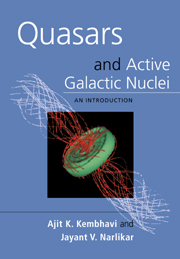Book contents
- Frontmatter
- Contents
- Preface
- Acknowledgments
- Acronyms and abbreviations
- 1 HISTORICAL BACKGROUND
- 2 THE COSMOLOGICAL FRAMEWORK
- 3 RADIATIVE PROCESSES–I
- 4 RADIATIVE PROCESSES–II
- 5 THE STANDARD MODEL
- 6 SURVEYS
- 7 LUMINOSITY FUNCTIONS
- 8 THE CONTINUUM
- 9 RADIO PROPERTIES
- 10 X-RAY EMISSION
- 11 X-RAY AND GAMMA-RAY SPECTRA
- 12 UNIFICATION
- 13 QUASAR ABSORPTION LINES
- 14 GRAVITATIONAL LENSING
- 15 PROBLEMS AND CONTROVERSIES
- References
- Books, reviews and proceedings
- Author index
- Subject index
1 - HISTORICAL BACKGROUND
Published online by Cambridge University Press: 05 June 2012
- Frontmatter
- Contents
- Preface
- Acknowledgments
- Acronyms and abbreviations
- 1 HISTORICAL BACKGROUND
- 2 THE COSMOLOGICAL FRAMEWORK
- 3 RADIATIVE PROCESSES–I
- 4 RADIATIVE PROCESSES–II
- 5 THE STANDARD MODEL
- 6 SURVEYS
- 7 LUMINOSITY FUNCTIONS
- 8 THE CONTINUUM
- 9 RADIO PROPERTIES
- 10 X-RAY EMISSION
- 11 X-RAY AND GAMMA-RAY SPECTRA
- 12 UNIFICATION
- 13 QUASAR ABSORPTION LINES
- 14 GRAVITATIONAL LENSING
- 15 PROBLEMS AND CONTROVERSIES
- References
- Books, reviews and proceedings
- Author index
- Subject index
Summary
Introduction: the energy problem
The discovery of quasi-stellar objects (QSOs or quasars) in 1963 represents a landmark in observational astronomy. Thanks to a coordination between optical and radio astronomers, it was possible to discover a new and important class of astronomical objects. Because this text book is all about quasars and related phenomena, it will not be out of place to begin at the beginning of the subject and to review briefly how these remarkable objects were first discovered.
The science of radio astronomy really began after the end of World War II, when some of the scientists and engineers engaged in wartime radar projects used their know-how to follow up the pioneering works of Karl Jansky in the 1930s and Grote Reber in the early 1940s. Thus radio dishes and interferometers appeared in England and Australia, at Jodrell Bank, Cambridge, Sydney and Parkes.
The early observations revealed the existence of cosmic radio sources and by the mid- 1950s it became an accepted fact that radio galaxies exist. The nature of their radiation was non-thermal, and its polarization properties indicated that its origin lay in the synchrotron process. As we will discuss in Chapter 3, in this process radiation comes from electrons accelerated by a magnetic field. Thus a typical radio source has as its energy reservoir the dynamical energy of relativistic particles and magnetic field energy.
In 1958 Geoffrey Burbidge drew attention to the enormous size of this energy reservoir.
- Type
- Chapter
- Information
- Quasars and Active Galactic NucleiAn Introduction, pp. 1 - 11Publisher: Cambridge University PressPrint publication year: 1999



